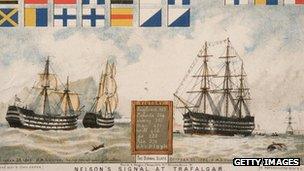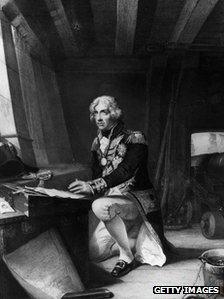How Lord Nelson's HMS Victory has been kept ship-shape
- Published

HMS Victory was bombed during World War II
Lord Nelson's flagship in the Battle of Trafalgar is to undergo a £16m restoration over five years.
It was announced on Thursday that BAE Systems has been awarded the multi-million pound contract to restore HMS Victory for future generations.
However, it is far from the first time the 246-year-old ship has needed major repairs.
Victory has reached an "astonishing age" for a ship made almost entirely of wood, according to Portsmouth Historic Dockyard.
Built between 1759 and 1765, the Victory is the oldest commissioned warship in the world.
The ship has sailed the high seas, fought major battles and been bombed, rammed by iron warships, eaten by gribbles (a type of sea worm), nibbled by beetles and rotted by fungus.
Even at the Battle of Trafalgar, the ship was considered to be past its best and had been due to be retired as a hospital ship.
Fast ship
However, Victory was popular with the admirals as it was a fast ship and when another warship sank, it was decided it should be modified and made fit for battle.
The Battle of Trafalgar became the most decisive British naval victory of the Napoleonic Wars.
During the fighting Nelson was killed and the Victory was badly damaged.
"She lost her mizzen-mast and limped into Gibraltar," said Andrew Baines, curator of HMS Victory.
Victory was repaired once more in Chatham dockyards and served in the Baltic before being decommissioned in 1812.

HMS Victory had to be towed to Gibraltar following the Battle of Trafalgar
Mr Baines said: "The navy talked about getting rid of her in the 1820s and a chap started writing letters to The Times and the Admiralty backed down.
"There's an apocryphal story that when Hardy was in charge of Portsmouth he told his wife he'd signed the order to have Victory broken up.
"She burst into tears and made him go back to the office to say he'd changed his mind."
The Victory became ever more popular with the public throughout the 19th Century, in step with the changing public perception of the navy and Admiral Nelson, according to Mr Baines.
'Naval hero'
"It would have been inconceivable that King George III would have dressed his children as sailors," he said.
"The navy was perceived as being rough.
"However, by the middle of 19th Century the Royal Family were dressing their children in sailor suits.
"Also there had been a lot of public concern about the way Nelson had been living his life, taking up with Emma Hamilton while his wife was still alive.
"Dying in battle allowed a lot of that to be swept under the carpet or quietly ignored.

Admiral Nelson had become a naval hero following the Battle of Trafalgar
"Nelson became a naval hero."
By the end of the 19th Century HMS Victory had been used as a training centre, for court martials and had become a Naval School of Telegraphy.
In 1903 the ship was rammed by HMS Neptune, which broke loose while being towed into the dockyard to be broken up for scrap.
The Society for Nautical Research restored HMS Victory to its original structure during the Battle of Trafalgar in the 1920s, so it could be used as a museum ship.
However further damage was done to the ship when a 500lb bomb fell between the dry dock wall and the Victory in 1941, damaging the original 1759 keel.
Today, about £1.5m a year is spent by the Ministry of Defence (MoD) on the maintenance of the vessel.
- Published1 December 2011
- Published1 December 2011
- Published5 July 2011
- Published27 May 2011
- Published27 May 2011
- Published25 January 2011